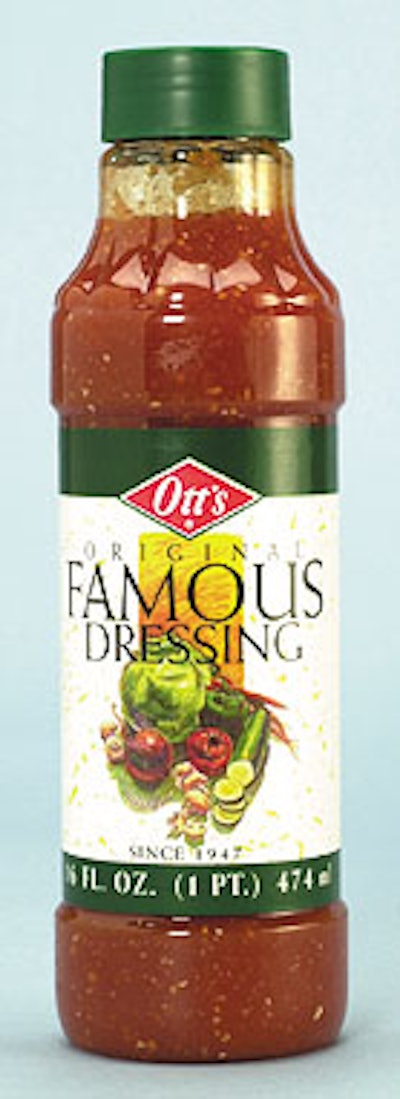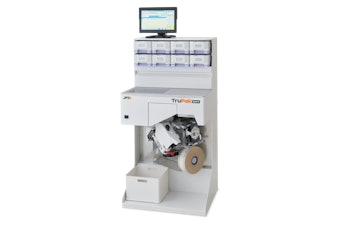Applied technology, engineered designs, and graphic capabilities all played key roles in the 2001 competition of the National Assn. of Container Distributors. Awards were presented in Alaska in mid-May at the annual meeting. (The Best of Show award for Richards Packaging and Diamond Magic is described more fully in the Analyst column p. 72.)
Winning the gold award in the food category was a 16-oz bottle of polyethylene terephthalate for Ott’s Original Famous Dressing. Sourced through Ryco Packaging (Omaha, NE), the bottle, which replaces a glass predecessor, was engineered with the help of blow molder Grafco (Hanover, MD). What makes the container unusual is that, even though it’s filled at a relatively high temperature, it’s not a product of heat-set technology. Instead it’s a “beefed-up” 42-g container engineered to help withstand the pressures of warm filling. Strategic ribbing at the bottom combines with liquid nitrogen dosing to prevent paneling when the product cools and internal pressure builds, says Mark Davis of Ryco.
Ryco has had several years experience designing and providing plastic bottles for warm filling assisted by nitrogen, which dramatically expands to keep the container rigid from filling all the way through cooling. Ryco account manager Don Becker credits Grafco with strong engineering assistance for this design.
The bottle’s goal was to resemble the previous glass bottle, although Ott’s installed a completely new filling line to accommodate the container and nitrogen dosing. “We’re not a large-volume company, and all our products, both retail and foodservice, had been packaged on the same line before,” says Dennis Gallemore, Ott’s plant manager. “It was out of date and we couldn’t convert it over to the retail plastic bottles very effectively. So we installed two new lines, one for retail, one for foodservice.”
Ott’s products undergo a pasteurization step prior to the packaging line, Gallemore says. The products are filled at about 120°F, which he says is about 10°F below the maximum the polyester bottle can handle. He says the company hadn’t had much problem with glass breakage, but it does eliminate a safety concern on the packaging line. Plus, Gallemore says that Ott’s sees a considerable savings in outbound freight costs due to lighter cases.
PET for honey
A similar conversion to PET was made by T. W. Burleson, Waxahachie, TX, when it worked with Berlin Packaging (Chicago, IL) and Parker Plastics (Pleasant Prairie, WI) on a new line of four bottle sizes (8, 12, 24 and 40 oz) for its clover honey. The containers won the bronze award. Previous bottles were molded from polypropylene. So the principal gain was to achieve glass-like clarity.
Much like the Ott’s change, the switch from extrusion/blown PP to injection/stretch-blown PET meant that bottle sizes would be reduced. “When we were in polypropylene, our containers were known as ‘tanks.’ I’m sure our new bottles in PET are lighter in weight,” says Tim Burleson, purchasing agent.
That’s why Burleson, Berlin and Parker worked so closely in designing the new bottles that, unlike extrusion-blown containers, would have predictable and consistent internal volume. Thus, when the correct weight is in the bottle, the fill level is right at the neck ring, every time. That permits the company to eliminate a neck band it had previously used to mask the varying fill levels caused by the differences in overflow volumes in the former bottles.
Another improvement is in the honeycomb embossed into the shoulder. “In polypropylene, the honeycomb embossing gave us a stippling effect that reduced the clarity,” Burleson says. “Plus we now can emboss all the way up to the neck.”
The new containers have been well received by the trade, he says, and he hopes the switch will have the same sales gain as when it shifted its “bear” bottles to PET, about two years ago.
The silver award in the food category went to Richards Packaging (Mississauga, Ontario, Canada) and Southwest Specialty Food Co. for the Rocket Fire Sauce bottle and fitments.
Other winners
Listed below are the NACD winners in the other six categories. To see photos, go to www.packworld.com/go/nacdwinners.
Household chemical category: gold to Twin City Bottle (Minneapolis, MN) and The Caldrea Co. for a bottle and closure for home care products; silver to O. Berk (Union, NJ) and Illume Candle Co. for screen-printed aluminum bottles for a room spray; bronze to Berlin Packaging (Chicago, IL) and Guardian Products for polyester bottles for cleaning products.
Cosmetics and personal care: gold to Berlin Packaging and Cosmetic Labs of America for frosted polyester bottles for new fragrances; silver to Packaging West (Aurora, CO) and Nordstrom for a bottle, tube and closure for TangoTwist, a seasonal promotion; bronze to Twin City Bottle and Progressive Beauty Brands for its Mossimo hair care bottles, closures and labels.
Drug and pharmaceuticals: gold to TricorBraun (St. Louis, MO) and Green Pharmaceuticals for a decorated aluminum can for Snore Stop Extinguisher; silver to TricorBraun and Allegiance Health Care for a 12-L container for collection of bodily fluids during surgery; bronze to Kaufman Container (Cleveland, OH) and ICN Biomedicals for a bottle, closure, and collar assembly for lotions.
General industrial and automotive: gold to North Pak Palmer Container (Twinsburg, OH) and Ashland Chemical for an F-style can and spout for insulation adhesives; silver to Richards Packaging and Bardahl for a bottle and closure for a custom designed bottle for automotive chemicals; bronze to TricorBraun and Senoret Chemical for a bottle and dispensing closure for a pesticide.
Pet and vet: gold to Kaufman Container and Miracle Corp. of Australia for bottles and dispensers for an equine shampoo; silver to All Pak (Bridgeville, PA) and Cedar Works for a tinted bottle that becomes a hummingbird feeder; bronze to Kaufman Container and Mensa Products for a modified stock bottle for Shed-X pet care products.
Novelty: gold to Kaufman Container and Changing Paradigms for a custom jar and custom closure insert for a home fragrance product; silver to O. Berk Co. and Bath and Body Works for a glass jar, roll-on fitment/ball and closure for a children’s glitter and fragrance; bronze to Industrial Container & Supply (Salt Lake City, UT) and Wasatch Beers for a bottle, closure, label, glassware, and bag for a gift pack at a microbrewery.



















